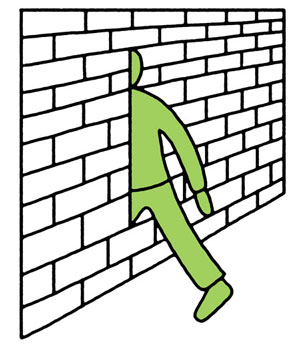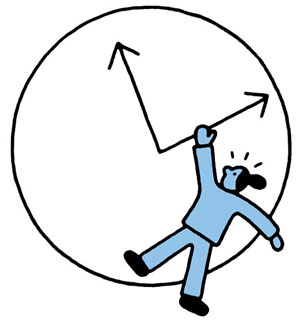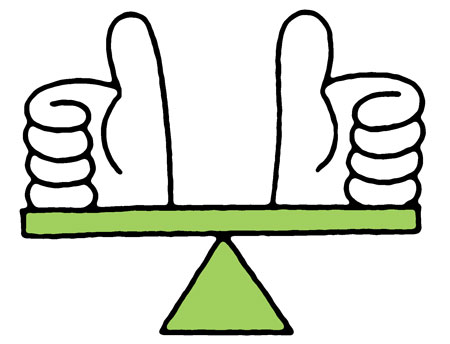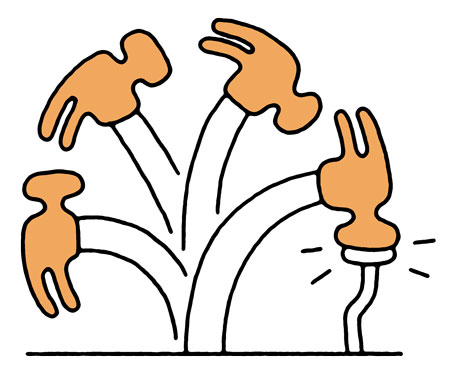
Illustrated by Tim Lahan
The Rev. Tod Bolsinger, Ph.D., has served as a pastor, professor, scholar, author, and consultant. In a new series of books on adaptive leadership the former seminary vice president takes on some of the ways leaders can meet the needs of the time. This is an edited and shortened version of Bolsinger’s thoughts from a conversation on the In Trust Center’s Good Governance podcast, Episode 79, at intrust.org.

Tempered Resilience for Leaders
In 2020, I wrote a book entitled Tempered Resilience, because when I talked to people about adaptive change, they all wanted to talk about sabotage. And this was right before the pandemic. Tempered Resilience was about how to develop the formation of resilience and wisdom to take a group of people through the resistance to change.
Edwin Friedman first talked about this. He said it’s part and parcel of the leadership process.
So, if you’re a president and a board, and you do a big strategic planning process and “Oh my gosh, the faculty doesn’t want to do it,” it’s not that the faculty is stubborn. It’s that people resist loss. You’re going to have to take them through the change.

Experimentation and Learning
I was working with a group of folks in Silicon Valley, and they have this phrase that you’ll hear in Silicon Valley where they’re doing tech stuff. It is: Fail fast, learn fast. If you fail fast, you’ll learn fast. And then a venture capitalist piped in and said: “And fail cheap; it’s my money. So fail fast, fail cheap, learn fast.”
I’ve reframed that to say: Look, if you’re learning, you’re not failing. So the first thing to do is reframe the question. The question isn’t “Did it work?” The question is always, “What did we learn and what did you learn?”
I was leading an initiative on vocation formation at a school. And when we started assessing students, we learned that there is a model of forming leaders that keeps them in their context and then pulls them to an environment where they can develop deep relationships. Over time that can be really transformative.
We were not assessing that, but we learned it. Today, it’s the only way I’ll teach.

Impact of the Pandemic on Leadership
In almost every school I know, they were forced to go online, and what happened is bad online education. But bad online education became an excuse for people to resist what could be the most transformative kind of education, which is a combination of both online and in-person. Wherever that is going on, almost every marker tells us that our students learn more, are excited about it more. But we absolutely just want to go back to what was familiar.
It’s not even nostalgia. It’s like it’s unconscious. We just want to go back to do the stuff that we know how to do. We default back to our old best practices even when they no longer work.

The Nature of Sabotage in Organizations
Sabotage is not the bad things that evil people do. It’s the human things that anxious people do. And one of the things that makes a group of people anxious – people whose entire careers have been about getting security (that is, tenure) – is change, and they sabotage the change.
It is really a very human thing to want the status quo. I always say whenever I’m working with groups: Don’t forget that the words “family” and “familiar” have the same root word. So you take somebody and ask them to do something unfamiliar or step into an unfamiliar environment, say, teach online, and what’s familiar is teaching in a classroom. They feel not just disoriented at that moment – they feel abandoned. They feel like a little kid who’s gone to Disney World and lost mom and dad on Main Street. It’s not the happiest place on earth until they first run home to mama. And what happens is everybody wants to go back to the familiar, and its because they’re anxious. That’s what stops most transformative change processes.
We talk about church being hard to change, or industries or businesses or military. Seminary is an 1,100-year-old business model.

Clarity of Mission and Values
Clarity is what’s really needed to allow you the health that you can then invest in the change that you need to make. We really have to get clear on what our values are and what is our mission. Many institutions fall into the trap of believing the goal is to preserve the institution. I work with a lot of church leaders. If you’ve ever been to New York City, there are all these beautiful cathedrals, and a lot of them are sparsely attended. Some of them are lovely and robust. And I said to some New York leaders: My goal is not to make sure your church survives; Paul’s churches didn’t survive. So let’s get really clear that the mission of God is bigger than any institution, and we’re then going to have to really grapple with that. What does it mean for us to be willing to learn, to face loss, to navigate competing values and to experiment because we don’t know the way, and then face with resilience the resistance that’s going to come?

Board Governance and Alignment
Boards have their own work to do, but that includes also being able to, every now and then, get up on a balcony with the executive team and ask, “What are some of the things out there that we should be looking at?”
I think a good board understands that it needs to do its work of maintaining the mission and creating an environment for a leadership team to be able to explore, experiment, come back with insights, and make decisions. Too many boards think “the president is the president, we’re Congress, and we have to be opposing.” No, we’re actually one leadership team with lots of different responsibilities.
We need to know our responsibilities. We need to do the ones that are our part, but we also need to all be stacking hands and looking in the same direction.
A president once talked about the biggest problem in most universities. He said “We’re one university of 28,000 faculty, staff and students, unified around a common parking problem.” It was the only thing they seemed to be able to agree on. That’s bad news.
If we can find there’s a certain mission that we all agreed on, then we can do our different roles – the board has a different role than executive leadership, which has a different role than faculty leadership – then I think we can actually work together collaboratively in a good way.

Hybrid Education Models
We found there was an interesting gap between the students in our residential campus and those in our regional campuses, who were using a hybrid methodology. Residential students were reporting they were not as satisfied or being formed as fast as our students in our regional campuses, where these were all people who came from a church setting or a community setting. They did stuff online, and they also came together once a year for a week. They used to call that seminary camp. It was like the best week of their lives. And they were so tight, and they kept those connections over the miles with their peers. And now I’ve built my entire doctor of ministry on this model. Today, it’s the only way I’ll teach.

Challenges in Theological Education
In our heart of hearts, all of us who came through seminary feel like we spent time in a monastery: There was this idyllic, formative location – deeply spiritual, deeply educational, really robust. And we are now leaders of those institutions because that worked for us. So now you’re trying to have a whole new generation of people who are trying to figure out how do you get theological education when the very best people in ministry are already doing ministry. So asking them to leave a church they love or a community or a second career and move to an idyllic little campus, take on debt, and study a bunch of books and then go back and find a job ... well, it just doesn’t even feel like it computes.

Four Big Mistakes Leaders Make
Relying on old practices: Leaders who try really hard with their old best practices think, “If I just work harder, this will work.” But the truth is, the world has changed, and those practices don’t solve the new problems.
Overworking without adapting: Almost every leader I know thinks they can outwork the changing world, and instead they need a different way of thinking about the problem.
Attempting to appease all stakeholders: Leaders believe that “If I just get all the stakeholders to agree, we’re all going to get everybody aligned.” So, we spend a lot of time trying to cut win-win deals that, after a while, are a lose-lose for everybody.
Failing to think differently: What I found was very often these really strategic, brilliant people were stuck in a few different ways of thinking that just didn’t apply anymore.